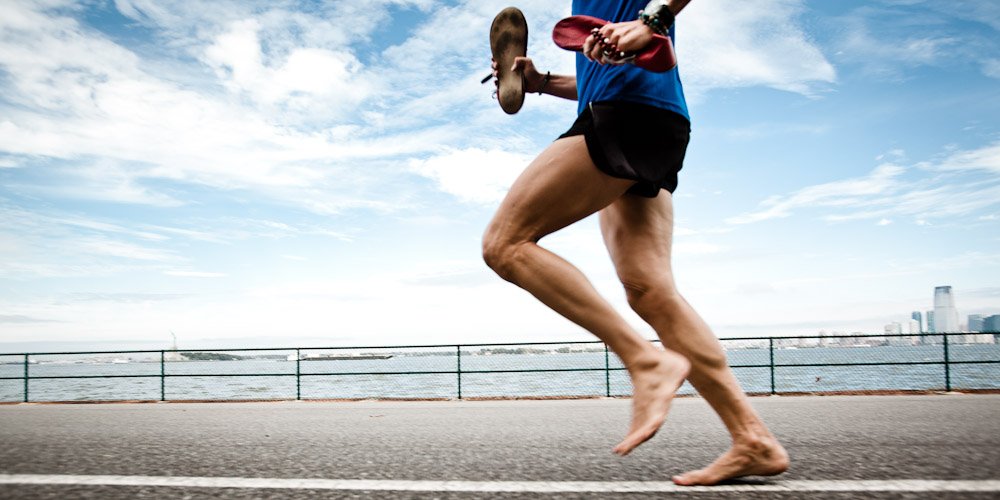
There is a lot of talk today about barefoot or minimalist shoe running and just how good it is for you. I am constantly asked in our physiotherapy clinic in Chelsea what my take on barefoot running is. Like all new crazes, it is the miracle, the panacea, the be all to end all.
But what are the facts and what are the myths about barefoot running? I will start with saying that I do not think barefoot running or in fact running is for everyone. It simply is not. I do not believe everyone is born to run either – depsite what Chris McDougall (author of “Born to Run”) might say. Not everyone is born to swim, play rugby, football and above all run. My advice would be see a professional with knowledge of running mechanics and see if you should be running.
We at Kensington Physio & Sports Medicine can help you in your quest to run and provide you with the knowledge, information & techniques required. If you have serious pathology of the chondral (cartilage) lining of the knees and ankles then perhaps cycling and swimming are better options due to their low impact forces. A recent article on the BBC highlighted a recent study looking at strike patterns and its effect on loading the body. BBC article If you change to barefoot or minimalist shoes then you also need to change your pattern of running otherwise injury will likely occur.
The facts are these:
1. Running in minimal shoes or barefoot uses less oxygen than running in normal trainers. Keep your trainers to less than 190g each and you will be more efficient. This makes sense – the heavier the shoe, the harder you work!
2. The heavier your shoes the more torque (force with direction) will be applied to the hip and knee. This is not a good thing. There are some comparisons between running in normal trainers and walking in high heels in terms of torque on the knees and hips.
3. Running with a heel (rearfoot) or a ball (forefoot) strike pattern does not effect your efficiency in terms of oxygen consumption when running barefoot or in minimalist shoes. It won’t effect how much oxygen you use but it sure as heel will hurt and lead to higher impact transient forces.
4. The way you run may be the most important factor. Landing on the heel (rearfoot) striking leads to higher peak transient forces than forefoot striking. This is not good as the time taken to reach peak force is reduced. The rate of loading (the time taken to reach peak load) is three times lower in barefoot forefoot strikers than those who heel strike either barefoot or in shoes.
5. Landing on the front of the foot (forefoot striking or FFS) causes a greater force output on the calf muscles compared to rearfoot (heel or RFS). This makes sense too – landing on the ball of the foot activates your calf muscle unlike landing on your heel. Therefore, you need to take it easy at the start of learning a new running style if you have been a rearfoot striker. Building up your calf and foot strength with drills and exercises taught to you by your physiotherapist is essential. So is planning the volume (amount) of running you do each session. This will help reduce the risk of achilles tendon issues and bone stress injuries. There have been a few studies highlighting the potential for injury if the transition to barefoot or minimalist shoes is too quick. Beware trendy shoes.
6. Landing with a FFS reduces the amount of knee flexion during the time your leg is on the ground. This means there is less stress/strain placed on the quadriceps and patella tendon. The implications of this are that if you are experiencing hip or knee pain during running that the reduced force will have a significant effect on your pain.
7. There is a correlation between high cadence (number of steps per minute) and reduced knee and hip torque. This is a positive correlation – it means if you run with more steps per minute you will have a reduced hip and knee torque in the wrong direction. This is a good thing. Recommended steps per minute are 180+ steps/minute.
8. There is growing concern about bone stress related injuries in the feet as a result of barefoot running. This is a real concern. As I said before, running is not for everyone. If you are running do the following:
– get your form/style checked out. It is amazing what people say once they see them self filmed “is that really me?” is the most common response! Lifestyle running
– train your self to run better. Your physio at Kensington Physio & Sports Medicine will show you the necessary drills and exercises required.
– start slow. Patience and a structured plan is key to getting you running properly. You will be using muscles you did not know existed and will require rest to get over the aches.
– wear the shoes that are best for you. Not everyone is supposed to wear little 5 finger trainers.
If you have any questions or would like your running reviewed then just call reception to get an appointment.
Cheers
Scott MSc(SEM, London) MCSP
Clinical Director
